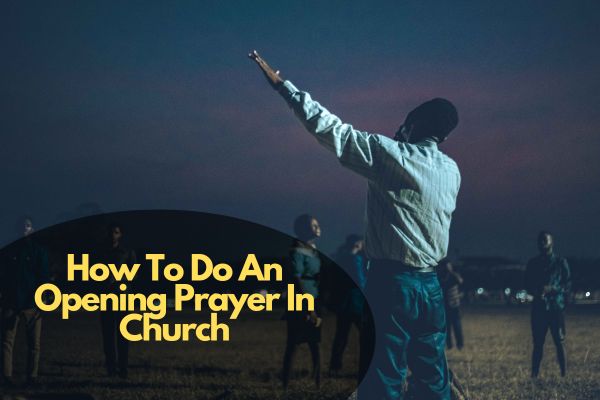An opening prayer in a church service holds significant importance as it sets the spiritual tone and prepares the congregation for worship. It is a moment when the community comes together to seek God’s presence, guidance, and blessing.
In this article, we will explore the purpose and elements of an opening prayer, as well as provide practical guidance on how to do an opening prayer in church
Contents
How To Do An Opening Prayer In Church
An opening prayer holds great significance in the context of a church service. It serves as a moment of reverence, setting the tone for worship and inviting the congregation to connect with a higher power. Whether you are a clergy member, a lay leader, or someone who has been entrusted with leading the opening prayer, this guide will provide you with practical steps and insightful tips on how to conduct an opening prayer in a church setting.
Step 1: Preparation and Reflection
Before leading an opening prayer, take some time to prepare yourself spiritually. Reflect on the purpose of the prayer and the message you aim to convey. Consider the theme of the service, the needs of the congregation, and any specific requests or events that require attention. Seek inspiration from sacred texts, hymns, or other spiritual resources to guide your prayer.
Step 2: Understand the Congregation
It is essential to have a good understanding of the congregation you are leading in prayer. Consider their diverse backgrounds, cultural sensitivities, and the overall tone of the service. Tailoring your prayer to resonate with the attendees will help create a meaningful and inclusive experience for everyone present.
Step 3: Start with Reverence
Begin the opening prayer by acknowledging the presence of a higher power and the sacredness of the moment. You can start with a brief invocation, such as “Dear Heavenly Father,” “Loving God,” or any other appropriate terminology based on your religious tradition. This sets the spiritual tone and invites the congregation to focus their minds and hearts.
Step 4: Express Gratitude
Expressing gratitude is a fundamental aspect of any opening prayer. Offer thanks for the opportunity to gather as a community, for the blessings received, and for the gift of life itself. Acknowledge the challenges and triumphs that the congregation has experienced and encourage gratitude for both the joys and the lessons learned.
Step 5: Address the Needs of the Congregation
A crucial element of an opening prayer is recognizing and addressing the needs, concerns, and emotions of the congregation. Pray for healing, comfort, guidance, and strength for those facing difficulties. Offer support and solace to those who are grieving or facing personal struggles. Additionally, remember to celebrate joys, milestones, and accomplishments within the community.
Step 6: Seek Divine Guidance
Invite divine guidance and wisdom for the church leaders, the congregation, and the broader community. Pray for discernment, unity, and clarity of purpose. Ask for guidance in decision-making processes and for the strength to overcome challenges.
Step 7: Conclude with a Benediction
As you wrap up the opening prayer, offer a benediction—a blessing or a word of encouragement—to the congregation. Invoke divine peace, love, and grace upon the attendees as they continue their spiritual journey. Encourage them to carry the spirit of the prayer into their daily lives and interactions.
Step 8: Allow Silence and Reflection
After the prayer, allow a moment of silence for personal reflection or meditation. This space allows individuals to internalize the prayer, connect with their spirituality, and respond in their way.
Purpose of an Opening Prayer
The opening prayer in a church serves multiple purposes. The purpose of an opening prayer in a church setting can be summarized in several key aspects:
- Invoking Divine Presence: The opening prayer serves as an invitation for the divine presence to be with the congregation. It acknowledges and welcomes the presence of a higher power, setting the spiritual atmosphere for the entire service.
- Fostering Reverence and Focus: The opening prayer helps to create a sense of reverence and sacredness among the worshippers. It allows individuals to transition from their daily concerns and distractions to a state of attentiveness and focus on the spiritual aspects of the gathering.
- Expressing Gratitude: Gratitude is an essential element of many opening prayers. Expressing thanks for the blessings received, the opportunity to gather as a community, and the gift of life itself helps to cultivate a spirit of gratitude within the congregation.
- Seeking Guidance and Wisdom: Opening prayers often include petitions for divine guidance, wisdom, and discernment. They ask for spiritual direction in decision-making processes, for leaders within the church, and for individual members seeking guidance in their lives.
- Addressing the Needs of the Congregation: The opening prayer provides an opportunity to acknowledge and address the needs, concerns, and emotions of the congregation. It can include prayers for healing, comfort, strength, and support for those facing challenges or difficult circumstances.
- Unifying the Congregation: An opening prayer can foster a sense of unity and shared purpose among the worshippers. It reminds them that they are part of a larger community and encourages them to come together in worship, fellowship, and support for one another.
- Setting the Tone and Theme: The opening prayer often reflects the overall tone and theme of the service. It can align with the sermon topic, the liturgical calendar, or the specific focus of the gathering. By setting the tone, the prayer helps to guide the spiritual journey of the congregation throughout the service.
Tips for Leading an Opening Prayer
Here are some tips for leading an opening prayer:
- Be Authentic: Your sincerity will resonate with the congregation. Speak from your heart and let your words reflect your genuine connection with the divine.
- Keep it Concise: An opening prayer should be relatively brief to set the right tone without overshadowing the rest of the service. Aim for a prayer that lasts about two to three minutes.
- Use Clear and Simple Language: Choose words and phrases that are easily understood by the congregation. Avoid jargon or overly complex language that might hinder comprehension.
- Maintain a Respectful Tone: Remember that you are leading a prayer in a sacred space. Use a respectful and reverent tone throughout the prayer, while also maintaining a warm and inviting atmosphere.
- Consider the Flow: The opening prayer should smoothly transition into the rest of the service. Consider how the prayer can connect with the themes or elements that follow, creating a cohesive worship experience.
- Engage the Congregation: Encourage active participation by inviting the congregation to respond to certain parts of the prayer. This can be done through brief moments of silence, communal affirmations, or the recitation of a simple refrain.
- Be Inclusive: Recognize the diversity within the congregation and strive to make the opening prayer inclusive. Use language and references that are broad enough to resonate with people from various backgrounds and beliefs.
- Be Mindful of Time: Keep an eye on the clock and be mindful of the overall service schedule. Ensure that the opening prayer does not run excessively long and cause delays.
- Practice and Rehearse: Take the time to practice delivering the prayer out loud. This will help you become comfortable with the flow of the words and ensure that you can deliver them smoothly during the service.
- Embrace Flexibility: While it is good to prepare, be open to the leading of the spirit in the moment. Allow for spontaneity and be willing to adapt the prayer if necessary to address any emerging needs or situations.
Conclusion
Leading an opening prayer in a church is a sacred responsibility that requires preparation, sensitivity, and genuine connection with the congregation. By approaching this task with reverence, gratitude, and an understanding of the needs of the community, you can create a meaningful and inclusive experience for all. Remember that the opening prayer sets the spiritual tone for the service and has the power to inspire, heal, and unite the congregation in their collective worship experience.








